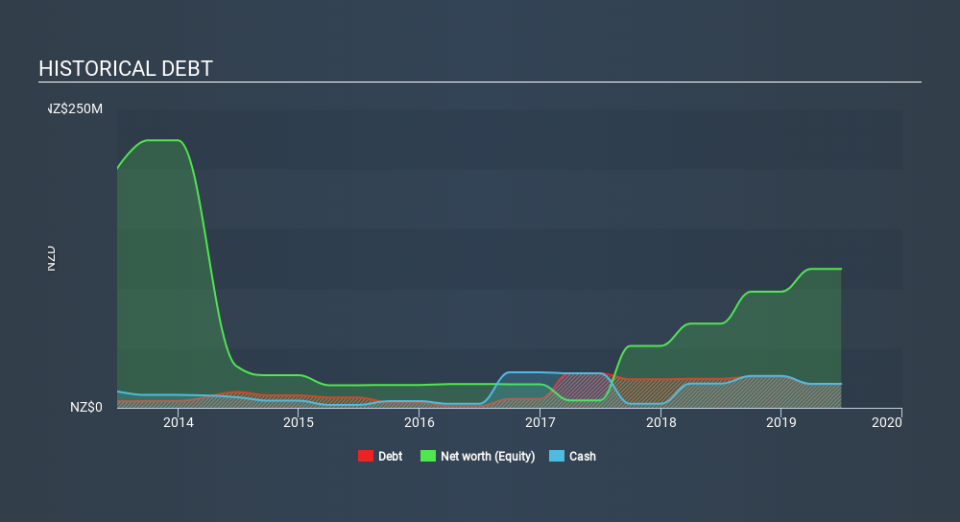Is Bathurst Resources (ASX:BRL) Using Too Much Debt?

David Iben put it well when he said, 'Volatility is not a risk we care about. What we care about is avoiding the permanent loss of capital. It's only natural to consider a company's balance sheet when you examine how risky it is, since debt is often involved when a business collapses. Importantly, Bathurst Resources Limited (ASX:BRL) does carry debt. But should shareholders be worried about its use of debt?
When Is Debt A Problem?
Debt and other liabilities become risky for a business when it cannot easily fulfill those obligations, either with free cash flow or by raising capital at an attractive price. If things get really bad, the lenders can take control of the business. However, a more frequent (but still costly) occurrence is where a company must issue shares at bargain-basement prices, permanently diluting shareholders, just to shore up its balance sheet. Of course, debt can be an important tool in businesses, particularly capital heavy businesses. When we think about a company's use of debt, we first look at cash and debt together.
View our latest analysis for Bathurst Resources
How Much Debt Does Bathurst Resources Carry?
You can click the graphic below for the historical numbers, but it shows that Bathurst Resources had NZ$19.6m of debt in June 2019, down from NZ$24.4m, one year before. But it also has NZ$20.0m in cash to offset that, meaning it has NZ$382.0k net cash.
A Look At Bathurst Resources's Liabilities
According to the last reported balance sheet, Bathurst Resources had liabilities of NZ$23.7m due within 12 months, and liabilities of NZ$19.4m due beyond 12 months. On the other hand, it had cash of NZ$20.0m and NZ$4.02m worth of receivables due within a year. So its liabilities total NZ$19.1m more than the combination of its cash and short-term receivables.
Given Bathurst Resources has a market capitalization of NZ$194.8m, it's hard to believe these liabilities pose much threat. But there are sufficient liabilities that we would certainly recommend shareholders continue to monitor the balance sheet, going forward. While it does have liabilities worth noting, Bathurst Resources also has more cash than debt, so we're pretty confident it can manage its debt safely.
It is well worth noting that Bathurst Resources's EBIT shot up like bamboo after rain, gaining 54% in the last twelve months. That'll make it easier to manage its debt. There's no doubt that we learn most about debt from the balance sheet. But ultimately the future profitability of the business will decide if Bathurst Resources can strengthen its balance sheet over time. So if you want to see what the professionals think, you might find this free report on analyst profit forecasts to be interesting.
But our final consideration is also important, because a company cannot pay debt with paper profits; it needs cold hard cash. While Bathurst Resources has net cash on its balance sheet, it's still worth taking a look at its ability to convert earnings before interest and tax (EBIT) to free cash flow, to help us understand how quickly it is building (or eroding) that cash balance. Over the last two years, Bathurst Resources actually produced more free cash flow than EBIT. That sort of strong cash generation warms our hearts like a puppy in a bumblebee suit.
Summing up
While it is always sensible to look at a company's total liabilities, it is very reassuring that Bathurst Resources has NZ$382.0k in net cash. The cherry on top was that in converted 649% of that EBIT to free cash flow, bringing in NZ$19m. So is Bathurst Resources's debt a risk? It doesn't seem so to us. There's no doubt that we learn most about debt from the balance sheet. But ultimately, every company can contain risks that exist outside of the balance sheet. Consider for instance, the ever-present spectre of investment risk. We've identified 3 warning signs with Bathurst Resources (at least 1 which can't be ignored) , and understanding them should be part of your investment process.
Of course, if you're the type of investor who prefers buying stocks without the burden of debt, then don't hesitate to discover our exclusive list of net cash growth stocks, today.
If you spot an error that warrants correction, please contact the editor at editorial-team@simplywallst.com. This article by Simply Wall St is general in nature. It does not constitute a recommendation to buy or sell any stock, and does not take account of your objectives, or your financial situation. Simply Wall St has no position in the stocks mentioned.
We aim to bring you long-term focused research analysis driven by fundamental data. Note that our analysis may not factor in the latest price-sensitive company announcements or qualitative material. Thank you for reading.

 Yahoo Finance
Yahoo Finance 
